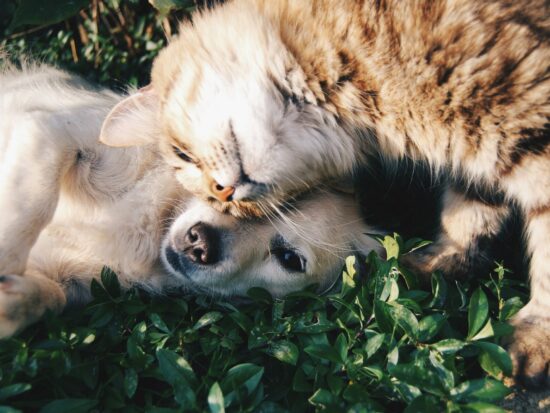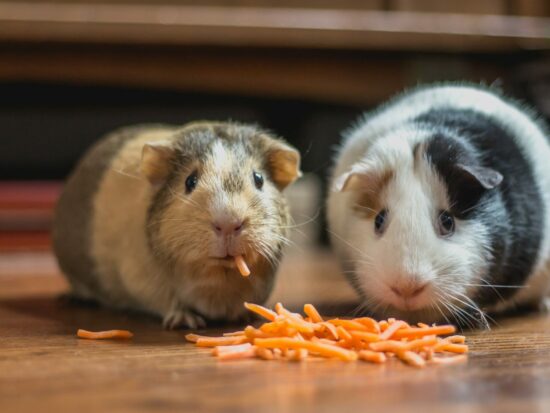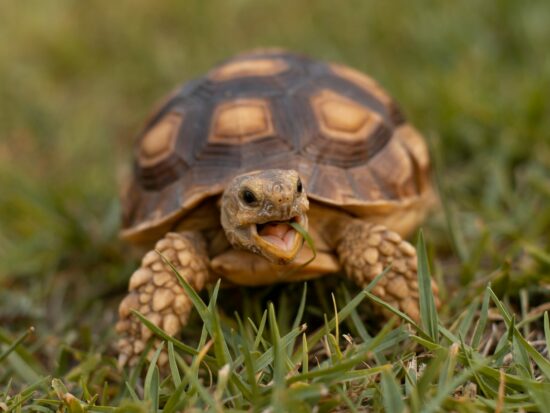15 Ways to Reduce Waste with Your Pets
Part 3 in our series: Reducing Waste Around the House

Do you have a dog, cat, bird, reptile, or other animal? While there are sure to be unique steps you can take to reduce waste for your particular pet, here are some general tips and tricks we came up with! You will notice we have also added an “In action” bullet point to each tip to show you how we are working to reduce waste with our unique pets!
Food
- Packaging – Is there a way to buy some or all of your pet’s food package-free (ex: fresh veggies from the Farmers Market or local grocery store), in paper packaging (ex: a paper bag instead of a plastic bag), or in bulk (ex: a 50 lb bag instead of 5 10 lb bags)?
- In action – We buy our bird feed, as well as rabbit pellets and hay, in bulk once a month to reduce shipping and packaging waste. We also reuse the bag the rabbit hay comes in for garbage collection. For our chihuahua, we are in the process of switching to a freeze dried feed, which drastically reduces packaging waste + energy costs for production and delivery.
- The Amount / Portioning Out – Do you find that your beloved pet picks and chooses what he or she likes and only eats that? Consider portioning out the food so that your pet is “forced” to eat everything, or at the very least, is not given the opportunity to waste so much. It might also help to speak with a trusted vet concerning the recommended portions for your specific animal.
- In action – Our bunnies love to pull out all their hay from their hay rack at once. Unfortunately, this often leads to a significant portion of the hay getting trampled on and soiled in their litter box. While we do compost all their poop, bedding, and wasted food, it is ideal to prevent wasting what we can on the front end. To remedy this, we have added wooden bars to their hay rack to prevent them from being able to pull so much out at once.
- Type / Sourcing – This part is difficult to provide sweeping tips for, as each pet is going to have unique dietary needs. Instead, here are some questions you can ask yourself about the type/sourcing of your pet’s food:
- What is their ideal food source(s)? Is it something pre-made? Is it fresh?
- What would my pet be eating if he or she lived in nature? Is this a healthy option for them living as a pet?
- What does my vet recommend for maintaining the health of my pet?
- Can I buy what I need from local farms or butcheries?
- Can I make what I need or grow/raise it at home?
- In action – Our chickens get our kitchen scraps, which means we spend less on feed costs, they get variety added to their diet, and we get one more use out of food waste before it goes to compost. Additionally, once spring comes, we plan to supplement our bunnies’ food with fresh pickings from the yard and garden.

Water
- Dishes – What do you use as a water dish? Instead of going to to buy something specifically marketed to pet parents, perhaps you can use something you already have! Stainless steel and glass bowls can make excellent dishes. If your pet needs a water bottle, look for glass options. (Note: If the water bottle comes with a plastic floater to spot water levels, we recommend taking this out to prevent the plastic leaching chemicals into the water.)
- In action – After trying out a bunny water bottle, we realized using a small glass food storage bowl worked even better. Bonus points for it being dishwasher safe, nontoxic (no chemicals leeching from the container into their water), and reused from something we already own! When we had our tortoise, we used a secondhand 9×13 glass baking pan as a soaking dish.
- Reuse water – Do you tend to dump half full glasses of water down the sink at the end of the day? Consider saving that “extra” or “waste” water for your pets. Your pet is not likely to mind, and over a year’s time span, imagine how much water you will save from going to waste. You could also save water during the time your shower or bath heats up by collecting it in a bucket. We have considered doing this, especially on days when the outdoor hoses are frozen, but our poultry still needs fresh water!
- In action – At our previous house, we had a water collection barrel positioned to collect runoff from our porch roof. We used this water for our chickens (and garden)!

Bathroom/Bedding/Clean Up
- Litter for the litter box – There is no need to buy synthetic litter for the litter box. These days there are tons of sustainable, nontoxic options, including those that are clay-based, pelleted flax, hemp, and spruce and balsam (the latter three can be purchased from New Country Organics, if you are in the market). Just remember to do your research on safe options for your pet, as some animals are sensitive to certain wood fibers or dust. Also consider how you will dispose of used litter. Can it be composted? Can you use something like the Litter Genie to lower plastic bag usage? Remember not to flush animal waste down the toilet or drain, as wastewater treatment processing is typically only designed to treat human waste.
- In action – One of our favorite swaps for litter is pine pellets. We can buy bulk bags from our local farm store, they contain no added binders or adhesives, and at the end of their use in the bunny litter box and duck coop, we can compost them.
- Bedding – Like litter, bedding options are quite expansive. Some items listed under the “Litter” bullet can actually double as bedding, depending on your animal. Consider purchasing package-free or bulk, if available, and supporting your local hardware store or a nearby farm. In addition to some of the options mentioned earlier, you might look into using wheat or barley straw, pine needles, leaves, or sand.
- In action – For our chicken coop, we use construction sand as the bedding and litter (NOT play sand, which is uniform in size). Sand has many benefits, including that it is easy to clean (we use a metal cat litter box scoop), it can be cleaned and reused, it provides grit for our chickens, and it is one of the more sanitary options of bedding. In fact, The Chicken Chick refers to sand as “The Litter Superstar” in this blog post.
- Scoopers and bags for collection – For a scooper, we recommend looking for a completely metal option. As far as bags go, we have not found a *perfect* solution. On the one hand, it sounds ideal to buy specifically-designed bags that are considered compostable/biodegradable. But, if you are throwing the bags in your trash (which will end up in a landfill) those bags are not likely to compost or biodegrade at all. That being said, we definitely like the idea of reducing our reliance on plastic. This one comes highly recommended, if you are in the market.
- Cleaning up messes – Reduce your dependency on paper towels by swapping them out for a set or two of sturdy cotton wash cloths or towels. While you are making the swap, we recommend keeping the cloths in the same spot you would go to grab a paper towel. It can also help to have a plan in place ahead of time for laundering the cloths. We have kept a trash can just for soiled cloths in our kitchen before, which was helpful for corralling cloths when our laundry room was on a different floor. Another tip for making the switch? Let yourself fully run out of paper towels before purchasing more, as you will then “force” yourself to start the habit of using cloths instead. We think once you go cloth, you will wonder how you ever did things before with those flimsy, thin disposables!
- A note on cleaning up particularly gross stuff – Keep a stash of old t-shirts and worn fabrics from which to pull when you are faced with cleaning up a particularly gross mess (think: bodily fluids, cleaning up after your dog or cat, etc.). You can toss them once used and feel guilt free since no extra waste will be generated!
- In action – We keep a stash of cotton cloths for cleaning up messes in the garage, laundry room, and kitchen so that they are easy to grab when messes come up. We have had great success using the “Sanitize” cycle on our washing machine for animal-related loads!

Toys
From squeakers to tugging to hide-outs and wheels, many animal toys are made from synthetic materials. We would like to encourage you to seek out alternatives that use eco-friendly materials, will not generate unnecessary waste, and do not contain toxic materials. In fact, you might even be able to find what you are looking for right outside your window (ex: sticks, pinecones, etc.) If you prefer to go the store-bought route, we have some bullets below that might be just what you are looking for!
- Rubber – Check out Kong’s Classic line made from USA-sourced natural rubber or Hevea’s options.
- Cotton and hemp – Check out From the Field’s or Purrfectplay’s dog and cat options.
- Wood – Check out Small Pet Select for a variety of toy options designed with small mammals and chickens in mind.
There you have it! 15 ways to reduce waste with your pets. Did we miss anything? Comment below to share your ideas with our community!
If you liked this article, you might enjoy perusing our other homestead posts. Click here to be redirected to our general homesteading page! Or click here to see our recommendations page, which includes a page for Dogs and a page for Poultry.
Yours truly,
Erica Barlow


 15 Ways to Reduce Waste in the Kitchen
15 Ways to Reduce Waste in the Kitchen